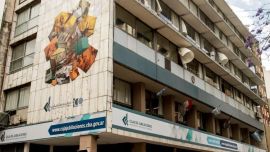More than 17.5 million people in Argentina are poor with poverty now affecting 44.7 percent of the population, according to the latest figures from the influential Observatorio de la Deuda Social of the Universidad Católica Argentina (Social Debt Observatory of the Catholic University of Argentina, ODSA-UCA).
Published just days before president-elect Javier Milei’s inauguration, the new report represents the final quarter of the year and concluded that 9.6 percent of Argentines live in extreme poverty.
The institution’s figures show a year-on-year increase in poverty indices. Both rates are the highest recorded by the observatory since 2006.
In the same quarter of 2022, the observatory had reported a rate of 44.1 percent, with extreme poverty affecting 8.1 percent of the population.
In addition, ODSA-UCA warned that quality of employment has fallen to its lowest level since 2004, with 33.1 percent of the economically active population over the age of 18 either unemployed (8.8 percent) or in unstable underemployment (24.3 percent).
The profile of the Observatorio de la Deuda Social rose considerably during the administration of former president Cristina Fernández de Kirchner, when official statistics supplied by the INDEC national statistics bureau became unreliable. Since then, its multidimensional approach to measuring poverty has been widely influential.
More than four in 10 Argentines are living in poverty according to the statistics agency, which is tasked with measuring official government data.
According to the ODSA-UCA data, some 18.7 million Argentines can’t afford the basic food basket (which includes not only food but also goods and services). The observatory estimates that some four million people are not satisfying their basic nutritional requirements.
Its latest poverty index shows an increase from 43.1 percent in 2022 to 44.7 percent in 2023, meaning that there are 17.5 million Argentines living with low income levels, precarious housing, insufficient health and education or food insecurity.
The work of the ODSA-UCA is based on a sample of 5,760 households in a geographical universe of large urban conglomerates covering metropolitan areas in Greater Buenos Aires, Greater Córdoba, Greater Rosario, Greater Mendoza, Salta, Neuquén, La Rioja, San Juan, Tierra del Fuego, Chubut and Chaco.
"The effects of inflation added to the stagnation of the economy and the situation of informal employment mean that poverty levels in Argentina have increased. And all indicators show that this increase in the number of poor or new poor people will continue to rise next year," warned Agustín Salvia, director of ODSA-UCA.
Salvia warned that "it is necessary to continue to provide social support to vulnerable sectors so that there is no social overflow.”
President-elect Milei has vowed to cut government spending and deliver austerity measures in order to reset Argentina’s economy.
For Salvia, "the cause of poverty has been and continues to be the lack of investment and balanced growth between dynamic sectors and traditional sectors, with the capacity to generate more and better jobs, or even decent jobs in the informal economy.”
Finally, the director of the Observatorio de la Deuda Social estimated that, if poverty is calculated on the basis of a person's income level and some basic lack of education, health, housing or services, the official rate "would rise to 65 percent.”
– TIMES/NA/PERFIL

























Comments